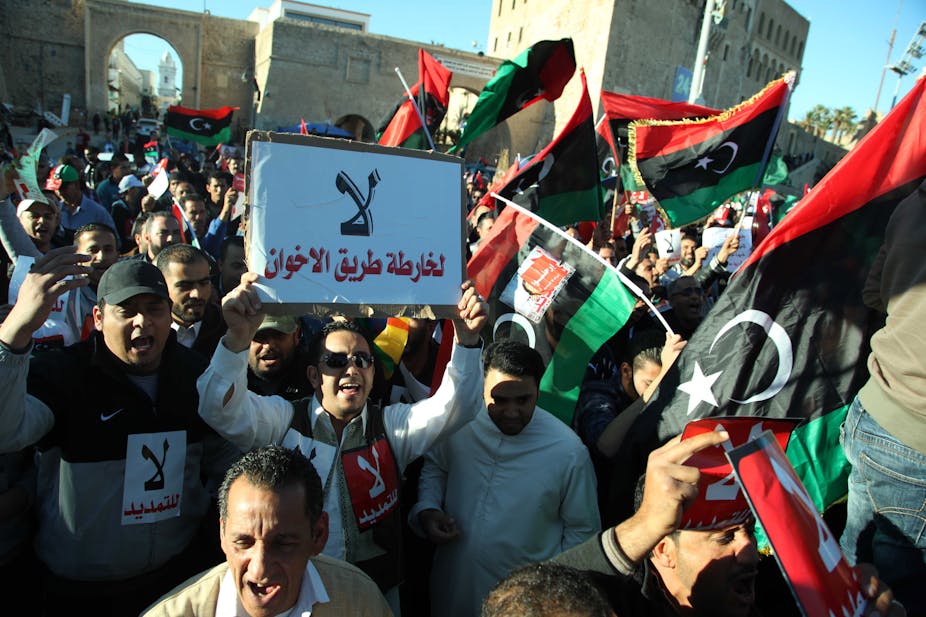For the first time in years, there is a new hope that the fragmentation of Libya can be averted, thanks to new rounds of UN mediation efforts.
There is a danger, however, that the media coverage accompanying these talks will actually fuel the conflict by perpetuating three fictions about the ongoing strife.
Reports of the situation in Libya usually describe a war between two groups. On one side is the anti-Islamist “internationally recognised government”, based in the eastern city of Tobruk and, on the other, “radical Islamists” who control a Tripoli-based government in the west. This simplistic account empowers hardliners on all sides of the conflict, making a negotiated settlement less likely. The truth is far more complicated.
Fiction one: this is a two-sided conflict
International coverage of the situation in Libya assumes that decisions are made from the top down, as they so often are in the west. But in fact, Libya’s political groups are organised less as hierarchies and more as networks. Their leaders are only one voice among many and decisions are based on consensus.
Near the end of the 2011 revolution, there were 236 fighting groups operating in Misrata, the country’s third-largest city. Each had its own command structure and identity, and ranged in size from nine to 1,727 fighters. On the western front of Misrata, 146 groups co-ordinated attacks and defence, but there was no leader. Instead, a group of 14-20 prominent commanders met every night to discuss strategy and decide on next steps.
Members would voice different opinions, and a consensus would emerge through hours of discussion. Some voices carried more sway, but there was no leader making choices on behalf of the group.
The political parties in Libya function in a similar way. They rely on consensus-based decision making among relative equals. The Tripoli-based coalition (sometimes called the Libya Dawn) is in fact a temporary alliance between dozens of political factions and hundreds of military units, each with its own identity and interests. It only decided to join the UN mediation efforts after days of group consultations and side discussions.
The Tobruk-based government is no different. There is an alliance of convenience between its political and military factions but the two have competing interests at times. And even within the military forces there are further divisions. What is often described as the Libyan National Army, is better understood as a coalition of local federalist-leaning militias, tribal-oriented confederations, disaffected military units, Zintani revolutionary battalions and Qaddafi-era military personnel.
Neither “side” in the conflict should be seen as a cohesive bloc, even though it is in the interest of these coalition leaders to portray themselves as unified groups.
Fiction two: the issues are national
Thanks to the densely networked and relationship-based makeup of Libya’s different political groups, the violence there is almost exclusively fuelled by local, not national, concerns. The 2011 revolution may have appeared to be a single uprising but it was actually more like a series of parallel, city-based armed revolts. Each had its own particular historic and political tensions.
Today’s violence is just as balkanised. The unrest in southern Libya, for example, plays out between two ethnic minorities – the Tebu and Tuareg. They clash over lucrative smuggling routes and control of oil installations.
Similarly, the clashes in Benghazi between General Khalifa Haftar’s coalition and an array of armed groups – ranging from Islamist-leaning militias to outright religious extremists – have parochial roots.

The only purely national conflicts are political, not military. These include disputes over who controls the nation’s oil and its central bank. The battle for legitimacy between Libya’s two duelling parliaments is being fought in the national and international media, which makes improving the accuracy of reporting crucial. As things stand, few Libyans see either parliament as legitimate.
Fiction three: Islamists v anti-Islamists
With the help of a partisan national media and a largely uninformed international press, Haftar has successfully demonised all his opponents as Islamist terrorists. Many Misratan military commanders are now equated with Islamic State – something they find comical and baffling.
The international media’s fixation on this simplistic dichotomy between anti-Islamists and religious extremists is problematic. Many Misratan commanders argue it trivialises the very real threat posed by Libya’s various extremist groups.
There are varying degrees of conservatism between the political and military groups on all sides. The commanders in Misrata acknowledge that many of its members are more conservative. But as one Misratan commander explained
Some of the groups are more conservative but they believe in democracy, which is all that matters to me. Besides, I would say most are less religiously conservative than the Republicans in the US Congress.
Most Libyan leaders occupy a middle ground and this tendency to pit two extremes against each other reduces their chances of negotiating a settlement. It empowers hardliners who use the rhetoric to justify their own aspirations for power.
A negotiated settlement is Libya’s only hope at this stage. Without one, violence will escalate. And with the increased media attention paid to UN mediation efforts, it is critical that we take more care in writing and reading about the situation there. This will empower moderates on all sides, increasing their chances of success. An opportunity like this is unlikely to appear again soon.

